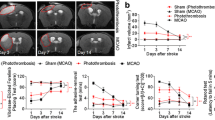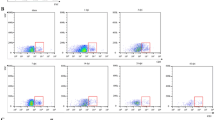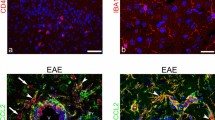Abstract
MRI was employed to follow the neurodegenerative foci and the localization of inflammatory cells by magnetically labeled CD4+ or CD8+ lymphocytes in the ischemia/reperfusion long-lived rats (9 and 13 months after 10 min of cardiac arrest). MRI of ischemic rats showed: (1) blood–brain barrier (BBB) leakage in the area of the dorsal hippocampus and brainstem-hindbrain level in basal cerebellum, (2) unlike anti-CD8 magnetic antibodies anti-CD4 ultra small paramagnetic iron oxide particles (USPIO) antibodies revealed hypointense areas in the brainstem-interbrain region and caudoputamen not found in animals that were not injected with USPIO antibodies, and (3) dilation in the retrosplenial area. Immunocytochemistry revealed microglial activation in the hippocampus and striatum, with indications of activation in thalamic lateral dorsal nuclei and the subventricular zone. In the CA1 and CA3 regions, it was noted that OX42- and ED1-positive granules appear in neuronal somata. Immunostaining of lymphocytes with TCR confirmed the T-cell presence in ischemic brain parenchyma of the hippocampus and striatum. The above observations thus point to a persistent dysfunction of BBB that in long-term may still lead to infiltration of T cells that are predominantly of helper (CD4+) type. Such inflammatory processes are backed by microglial activity even up to 1 year after ischemia/reperfusion. Moreover, in these animals an augmented expression of neurogenesis markers and neuroblast migration was also revealed in the subventricular zone. Thus, a balance of degenerative processes and inflammatory surveillance with neurogenesis could determine the long-term outcome of global ischemia survival or the previously proposed formation of amyloid plaques and Alzheimer’s-type dementia.



Similar content being viewed by others
Abbreviations
- BBB:
-
Blood–brain barrier
- CLIO:
-
Cross-linked iron oxide
- CNS:
-
Central nervous system
- DCX:
-
Doublecortin
- FITC-streptavidin:
-
Streptavidin labeled with fluorescein isothiocyanate
- FoW:
-
Field of view
- Gd-DTPA:
-
Gadolinium-diethylenetriaminepentaacetic acid
- MRI:
-
Magnetic resonance imaging
- PECAM:
-
Platelet endothelial cell adhesion molecule
- RF:
-
Radio frequency
- SPIO:
-
Small paramagnetic iron oxide particles
- SVZ:
-
Subventricular zone
- T1:
-
Longitudinal relaxation time
- T1W:
-
T1-weighted relaxation
- T2*:
-
Transversal relaxation time-“star” protocol
- T2*W:
-
T2*-weighted relaxation
- TCR:
-
T cell receptor
- TE:
-
Time to echo
- TR:
-
Repetition time
- TSE:
-
Turbo spin echo protocol
- USPIO:
-
Ultra small paramagnetic iron oxide particles
References
Arshavsky YI (2010) Why Alzheimer’s disease starts with a memory impairment: neurophysiological insight. J Alzheimer’s Dis 20:5–16
Bowen S, Ateh DD, Deinhardt K et al (2007) The phagocytic capacity of neurones. Eur J Neurosci 25:2947–2955
Darsalia V, Heldmann U, Lindvall O et al (2005) Stroke-induced neurogenesis in aged brain. Stroke 36:790–1795
Dousset V, Ballarino L, Delalande C et al (1999a) Comparison of ultrasmall particles of iron oxide (USPIO)-enhanced T2-weighted, conventional T2-weighted, and gadolinium-enhanced T1-weighted MR images in rats with experimental autoimmune encephalomyelitis. Am J Neuroradiol 20:223–227
Dousset V, Delalande C, Ballarino L et al (1999b) In vivo macrophage activity imaging in the central nervous system detected by magnetic resonance. Magn Reson Med 41:329–333
Ekdahl CT, Kokaia Z, Lindvall O (2009) Brain inflammation and adult neurogenesis: the dual role of microglia. Neuroscience 158:1021–1029
Floris S, Blezer ELA, Schreibelt G et al (2004) Blood-brain barrier permeability and monocyte infiltration in experimental allergic encephalomyelitis: a quantitative MRI study. Brain 127:616–627
Flügel A, Schwaiger FW, Neumann H et al (2000) Neuronal FasL induces cell death of encephalitogenic T lymphocytes. Brain Pathol 10:353–364
Hallenbeck J, del Zoppo G, Jacobs T, Immunomodulation Workshop Participants et al (2006) Immunomodulation strategies for preventing vascular disease of the brain and heart. Stroke 37:3035–3042
Huang G-J, Smith AL, Gray DHD et al (2010) A genetic and functional relationship between T cells and cellular proliferation in the adult hippocampus. PLoS Biol 8:e1000561
Kiryk A, Pluta R, Figiel I et al (2011) Transient brain ischemia due to cardiac arrest causes irreversible long-lasting cognitive injury. Behav Brain Res 219:1–7
Kokaia Z, Thored P, Arvidsson A et al (2006) Regulation of stroke-induced neurogenesis in adult brain: recent scientific progress. Cereb Cortex 16(Suppl 1):i162–i167
Kuan CY, Schloemer AJ, Lu A et al (2004) Hypoxia–ischemia induces DNA synthesis without cell proliferation in dying neurons in adult rodent brain. J Neurosci 24:10763–10772
Lipton P (1999) Ischemic cell death in brain neurons. Physiol Rev 79:1431–1568
Nakatomi H, Kuriu T, Okabe S et al (2002) Regeneration of hippocampal pyramidal neurons after ischemic brain injury by recruitment of endogenous neural progenitors. Cell 110:429–441
Nighoghossian N, Wiart M, Cakmak S et al (2007) Inflammatory response after ischemic stroke: a USPIO-enhanced MRI study in patients. Stroke 38:303–307
Perry VH, Gordon S (1987) Modulation of the CD4 antigen on macrophages and microglia in rat brain. J Exp Med 165:1218–1223
Pirko I, Ciric B, Johnson AJ et al (2003) Magnetic resonance imaging of immune cells in inflammation of central nervous system. Croat Med J 44:463–468
Pluta R (2006) Is the ischemic blood-brain barrier insufficiency responsible for full-blown Alzheimer’s disease? Neurol Res 28:665–671
Pluta R (2007) Role of ischemic blood-brain barrier on amyloid plaques development in Alzheimer’s disease brain. Curr Neurovasc Res 4:121–129
Pluta R, Lossinsky AS, Mossakowski MJ et al (1991) Reassessment of a new model of complete cerebral ischemia in rats. Method of induction of clinical death, pathophysiology and cerebrovascular pathology. Acta Neuropathol 83:1–11
Pluta R, Ułamek M, Jabłoński M (2009) Alzheimer’s mechanisms in ischemic brain degeneration. Anat Rec 292:1863–1881
Pluta R, Januszewski S, Jabłoński M et al (2010) Factors in creepy delayed neuronal death in hippocampus following brain ischemia-reperfusion injury with long-term survival. Acta Neurochir Suppl 106:37–41
Rausch M, Hiestand P, Baumann D et al (2003) MRI-based monitoring of inflammation and tissue damage in acute and chronic relapsing EAE. Magn Reson Med 50:309–314
Ridge JP, Di Rosa F, Matzinger P (1998) A conditioned dendritic cell can be a temporal bridge between a CD4 T-helper and a T-killer cell. Nature 393:474–478
Saleh A, Schroeter M, Jonkmanns C et al (2004a) In vivo MRI of brain inflammation in human ischemic stroke. Brain 127:1670–1677
Saleh A, Wiedermannn D, Schroeter M et al (2004b) Central nervous system inflammatory response after cerebral infraction as detected by magnetic resonance imaging. NMR Biomed 17:63–69
Sastre M, Dewachter I, Landreth GE et al (2003) Nonsteroidal anti-inflammatory drugs and peroxisome proliferator-activated receptor-gamma agonists modulate immunostimulated processing of amyloid precursor protein through regulation of beta-secretase. J Neurosci 23:9796–9804
Schroeter M, Jander S, Witte OW et al (1994) Local immune responses in the rat cerebral cortex after middle cerebral artery occlusion. J Neuroimmunol 55:195–203
Schwartz M, London A, Shechter R (2009) Boosting T-cell immunity as a therapeutic approach for neurodegenerative conditions: the role of innate immunity. Neuroscience 158:1133–1142
Selakovic V, Raicevic R, Radenovic L (2009) Temporal patterns of soluble adhesion molecules in cerebrospinal fluid and plasma in patients with the acute brain infraction. Dis Markers 26:65–74
Stoll G, Bendszus M (2009) Imaging of inflammation in the peripheral and central nervous system by magnetic resonance imaging. Neuroscience 158:1151–1160
Stoll G, Jander S, Schroeter M (1998) Inflammation and glial responses in ischemic brain lesions. Prog Neurobiol 56:49–71
Sugawara T, Fujimura M, Noshita N et al (2004) Neuronal death/survival signaling pathways in cerebral ischemia. NeuroRx 1:17–25
Thored P, Arvidsson A, Cacci E et al (2006) Persistent production of neurons from adult brain stem cells during recovery after stroke. Stem Cells 24:739–747
Touzani O, Boutin H, LeFeuvre R et al (2002) Interleukin-1 influences ischemic brain damage in the mouse independently of the interleukin-1 type I receptor. J Neurosci 22:38–43
Wolf SA, Steiner B, Akpinarli A et al (2009) CD4-positive T lymphocytes provide a neuroimmunological link in the control of adult hippocampal neurogenesis. J Immunol 182:3979–3984
Yang SH, Simpkins JW (2007) Ischemia-reperfusion promotes tau and beta-amyloid pathology and a progressive cognitive impairment. In: Pluta R (ed) Ischemia-reperfusion pathways in Alzheimer’s disease. Nova Science Publishers, Inc., New York, pp 113–138
Yilmaz G, Arumugam TV, Stokes KY et al (2006) Role of T lymphocytes and interferon-γ in ischemic stroke. Circulation 113:2105–2112
Ziv Y, Ron N, Butovsky O et al (2006) Immune cells contribute to maintenance of neurogenesis and spatial learning abilities in adulthood. Nat Neurosci 9:268–275
Acknowledgments
The authors are grateful to Dr. Goran Bačić for his continuous expert support in designing and analyzing MRI experiments. This study was supported by grant of Ministry of Science and Technological Development Republic of Serbia (Grant No. 41005), funds from Mossakowski Medical Research Centre (T5), Polish Ministry of Science and Higher Education (2007–2010-Cost/253/2006), and ESF-COST Action B30.
Author information
Authors and Affiliations
Corresponding author
Additional information
R. Pluta and P. R. Andjus contributed equally to this work.
Electronic supplementary material
Below is the link to the electronic supplementary material.
429_2011_336_MOESM1_ESM.mpg
Supplementary material 1 Online Resource 1. Animated reconstruction of the Z-stack of the image in Fig. 1e for the postischemic CA1 hippocampal region (optical slice thickness – 0.79 μm, number of slices – 52, stack size – 40.2 μm) (MPEG 621 kb)
429_2011_336_MOESM2_ESM.mpg
Supplementary material 2 Online Resource 2. Animated reconstruction of the Z-stack of the image in Fig. 1e for the postischemic striatal region (optical slice thickness – 1.99 μm, number of slices – 14, stack size – 25.9 μm) (MPEG 469 kb)
Rights and permissions
About this article
Cite this article
Sekeljic, V., Bataveljic, D., Stamenkovic, S. et al. Cellular markers of neuroinflammation and neurogenesis after ischemic brain injury in the long-term survival rat model. Brain Struct Funct 217, 411–420 (2012). https://doi.org/10.1007/s00429-011-0336-7
Received:
Accepted:
Published:
Issue Date:
DOI: https://doi.org/10.1007/s00429-011-0336-7




